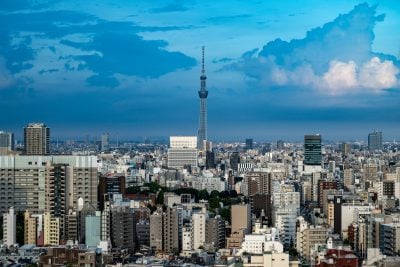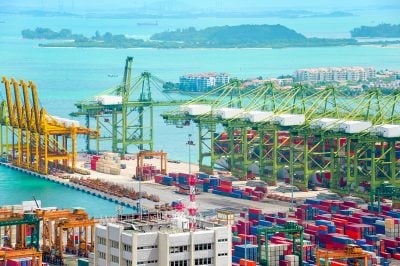Tema is the most important entry port in Ghana, handling around 70% of total maritime cargo to and from the country. But the volume of throughput now far exceeds the port’s handling capacity, leading to long queuing for ships and slower trade. But, Francis L Sackity reports from Accra, plans are afoot to rapidly expand the port.
Bolloré Africa Logistics Ghana Limited is to invest about $15m in infrastructural upgrading at the Tema Port as part of efforts aimed at expanding facilities there to meet rising demand.
The investment will go into the purchase and installation of cranes, reach stackers, ship to-shore cranes, among others, and will be done through its local partners, Meridian Port Services (MPS), a joint venture between Bolloré and the Ghana Ports and Harbours Authority (GPHA). MPS has, since 2007, been managing the container terminal at the Tema Port and has, together with its partners, invested about $100m into the container terminal after taking over its operations from the GPHA.
The Tema Port, one of the two sea ports in Ghana, handles about 70% of total maritime freight to and from the country. There has been increasing pressure on the facilities there as cargo throughput continues to rise and that has led to delays in loading, offloading and cargo clearance.
To help close the infrastructure deficits and reduce handling challenges, Bolloré and its local partner, MPS, had resolved to expand the harbour’s equipment base. Meanwhile, traffic at the port continues to increase.
Cargo throughput at Tema rose by 26.4% in 2011 to 11m tonnes, while container volumes grew 28.3% to 756,899 twenty-foot equivalent units (TEUs). Container traffic through the port grew from about 343,000 TEUs in 2004 to about 526,000 TEUs in 2009 and then to 822,000 in 2012, a growth of 56% in three years, with limited vessel facilities at the port.
Total cargo traffic through the port rose to 9.2m metric tonnes in 2004 and dropped to 7.4m in 2009 but rose to 11.5m metric tonnes in 2012, a similar growth of 55% in three years.
For the year ending 2012 alone, 511 full cellular container vessels called at the port, with 33 multipurpose container vessels, 162 Ro-Ro (roll-on-roll off) vessels and 104 refrigerated vessels also served by the port. In the 12 months of 2012, the port discharged about 156,000 vehicles, or an average of 540 vehicles per working day, into the Ghanaian economy.
Bolloré Africa Logistics has perhaps the widest integrated logistics network on the African continent and is currently the leading operator of publicprivate partnerships in the port and rail sectors. It has a presence in 56 countries, including 45 in Africa and a workforce of 25,000.
It was created in 2008, uniting all activities on the African continent and in the countries that have commercial relations with Africa.
The Ghana Ports and Harbours Authority (GPHA) has also initiated steps to reclaim about half a kilometre of sea, three kilometres westward of the Tema Port to secure more space for expansion to meet increasing demands of the maritime industry. The expansion project, expected to cost about $1bn, will involve reclamation, dredging, the provision of breakwaters and the construction of container terminals and a cruise terminal. A Chinese team of experts in the marine business involved in container manufacturing, the provision of container terminals, among others, has been in the country to have first-hand information on the Tema Port. According to the acting director-general of the GPHA, Richard Abugri Anamoo, the Tema and Takoradi Ports had become too small to manage the present growth in maritime business. He said the situation had made it necessary for the management of the GPHA to seek partnership and support to meet the demands of maritime transport.
The Chinese team, led by Qui Jingung, the deputy managing director of Cosco Pacific Limited, a Chinese investment company in Hong Kong, inspected the land area along the west coast end of the port, the main port and the Golden Jubilee Container Terminal and observed the congestion at the port.
Cosco Pacific is a publicly listed company owned by China Cosco Holdings Company Ltd, a subsidiary of Cosco Group. Listed in Hong Kong Stock Exchange in December 1994, its main business areas include container leasing container, terminals operation and logistics and container manufacturing.
Efficiency gains
Tema has already made some efficiency gains, thanks in no small part to the involvement of MPS. The firm operates two of Tema’s 12 berths in a container terminal constructed on a public-private partnership (PPP) agreement. An increase in maximum vessel length to 250 metres from 230 metres in 2011 was a step in the right direction.
However, Tema still lags behind regional competition, such as the ports of Apapa in Nigeria, Lomé in Togo and Abidjan in Côte d’Ivoire. Tema’s draught of 11.5 metres means that some ships have to call elsewhere first to lighten loads, or avoid Ghana altogether.
To this end, the GPHA has outlined plans for expansion.
These include deepening the draught to 16 metres, which would allow access to vessels of up to 10,000 TEUs, and adding seven new terminals, including a container facility and terminals for passengers, “roll-on-roll off” vessels, fruit and sugar, and trans-shipment, at a total cost of $1.5bn. While no solid time line for the development has been announced, the GPHA is likely to seek a PPP for the development.
Recent vessel traffic calling at the port generated such long queues at the anchorage that some shipping lines were compelled to drop their North American direct calls to Tema from 12 vessels per month to only two vessels per month.
The Tema expansion project will see the creation of at least 23 new berths along nearly 7.8km length of quay walls, two 600m-diameter turning basins for 300m-LOA (length overall) vessels drawing 16m of water, 6km newly constructed and reengineered breakwaters, with cargo and passenger terminals spread over 400 hectares of land reclaimed from the sea to be linked by 11km of new dedicated port-access roads into the Ghanaian economy.
The business world cannot wait to see this expansion since many are concerned over the undue delays in clearing their goods due to the challenge of space at the ports.
Want to continue reading? Subscribe today.
You've read all your free articles for this month! Subscribe now to enjoy full access to our content.
Digital Monthly
£8.00 / month
Receive full unlimited access to our articles, opinions, podcasts and more.
Digital Yearly
£70.00 / year
Our best value offer - save £26 and gain access to all of our digital content for an entire year!
 Sign in with Google
Sign in with Google 


